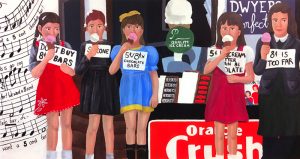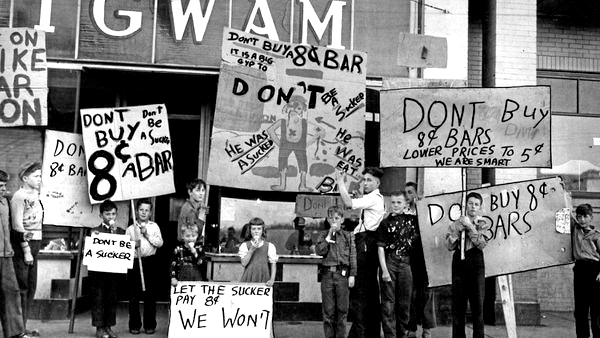The Candy Bar War
Imagine if the price of your favourite treat went up 60% overnight. Wouldn’t you be upset?
Well, this is precisely what happened on April 25th, 1947, after the end of World War 2 when government price controls were removed. Wages remained low. Money was tight.
A group of Ladysmith kids went to the local candy store, called The WigWam. Anticipating the delicious taste of their favourite chocolate bars, they were shocked to find that instead of 5¢, the bars now cost 8¢! This was a huge blow as their pocket money – if they were lucky enough to get any – was about 15¢ weekly. It meant that their pocket money wasn’t enough – they couldn’t afford chocolate bars!
Well, the kids didn’t take this lying down….
They decided to gather their friends and parade downtown with signs protesting the price rise. With their motto ‘Don’t be a sucker – don’t buy 8¢ candy bars’ they encouraged kids to go on strike by not buying 8¢ candy bars in an attempt to force the candy companies to lower their prices. One of the kids, 16-year-old Parker Williams, had an old truck – a 1923 McLaughlin. This was daubed with slogans: kids piled in and others marched behind waving placards and chanting
We want a 5¢ chocolate bar
8¢ is too high by far
Get behind our buyers’ strike
A 5¢ chocolate bar
rah rah rah
They protested for three days in succession. Initially viewed with amusement by adults, the protest spread, first across Vancouver Island, then over to Vancouver and from there all across Canada. This was serious politics. Kids everywhere were marching and demanding a return to the 5¢ chocolate bar by singing the Candy Bar Song.
Unfortunately, it all came to an end without the price being lowered. Accusations of communists influencing the kids to cause chaos, combined with the candy companies justifying the hike in price due to increased production costs and product shortages, lowered public support for the movement, and by the middle of May, the protest had fizzled out.
Unlike the 5¢ candy bar, the WigWam survived along with the story of how a children’s protest in a small town turned nationwide.

A mural in Chemainus, Vancouver Island, showing kids licking 5¢ ice cream cones instead of eating 8¢ chocolate bars while protesting against the rise in price of chocolate from 5¢ to 8¢ during the 1947 Candy Bar War. Painted: 2017


